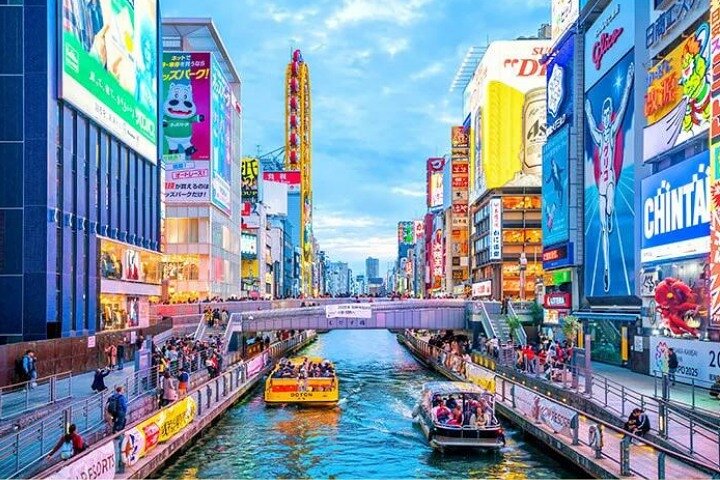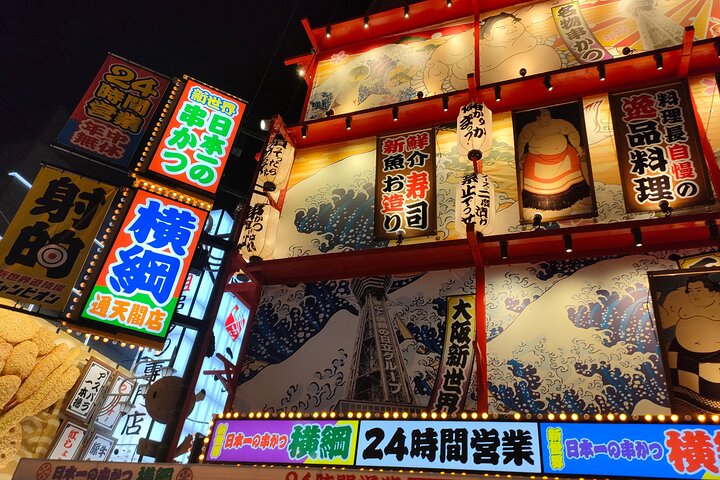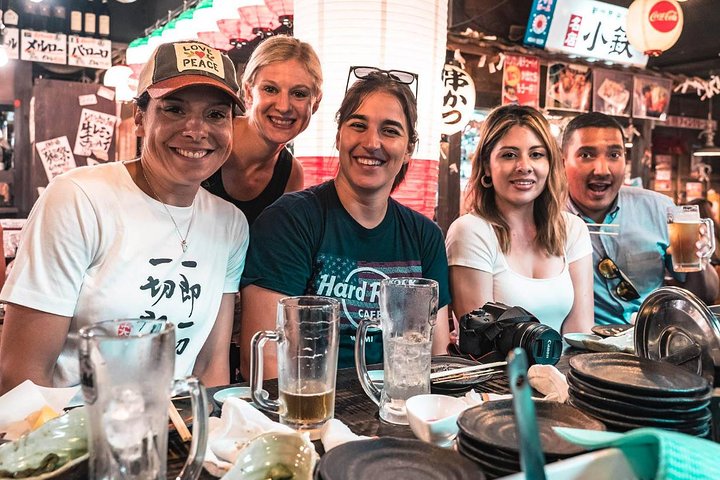9 Days In Depth Cultural Japan Small Group Tour
Overview
Available languages
216 hours
Mobile ticket
Explore the Golden Pavilion in Kyoto
Visit the sacred Fushimi Inari Shrine
Stroll through Nara Park with friendly deer
Experience Hiroshima Peace Memorial Park
View Mount Fuji from Arakurayama Park
Additional Info
Wheelchair accessible
Infants and small children can ride in a pram or stroller
Public transportation options are available nearby
Infants are required to sit on an adult’s lap
Transportation options are wheelchair accessible
All areas and surfaces are wheelchair accessible
Not recommended for travelers with spinal injuries
Not recommended for pregnant travelers
Not recommended for travelers with poor cardiovascular health
Suitable for all physical fitness levels
Cancellation Policy
All sales are final. No refund is available for cancellations.
What‘s Included
Entrance fees for mentioned sights visited.
Hotel accommodation with twin-sharing basis
Minbus with driver
Service of English speaking guide per itinerary
Public transport like express bus/train, bullet train during the trip
International flight into Osaka/Kyoto and out of Tokyo.
Japan visa fee.
Gratuities
Lunch and dinner
airport pick-up service
What To Expect
Welcome to Japan!
Accommodations
KYOTO TOKYU HOTEL(4-star hotel)
Kyoto
Arrive in Osaka by flight. Get to Kyoto and head to your hotel in Kyoto on your own.Welcome to Kyoto! Once you arrive and check in at the hostel you’ll then have plenty of time to recover from your flight and relax before you meet everyone in your group. If you require airport pick-up service, please let us know in advance. We can arrange a private transfer from the airport to your hotel for you. Please note that this service comes with an additional cost.
Kyoto Tour | Kinkakuji Temple, Nijo Castle
Accommodations
KYOTO TOKYU HOTEL(4-star hotel)
Food and Drinks
BREAKFAST
Breakfast
Kinkakuji Temple
After breakfast, you can spend the morning at your leisure — relax at the hotel to unwind from your journey or explore the beautiful city of Kyoto on your own. In the afternoon, your guide and driver will pick you up from the hotel and take you to visit Kinkaku-ji Temple (Golden Pavilion), also known as Rokuon-ji Temple. Built in 1397, it was originally the villa of Ashikaga Yoshimitsu, later converted into a Zen temple, and inscribed as a UNESCO World Heritage Site in 1994. The main attraction is the three-story pavilion entirely covered in gold leaf, known as the Kinkaku (Golden Pavilion). On clear days, its brilliant reflection shimmers in the pond in front of the temple, creating a breathtaking view. During autumn, the golden structure contrasts beautifully with the surrounding red leaves, offering an unforgettable sight.
Nijo Castle
Next, you will continue to another World Cultural Heritage site — Nijo Castle, built in 1603 as the Kyoto residence of Tokugawa Ieyasu, symbolizing the power of the Edo Shogunate. It played a significant role in Japanese history and was where the shogunate finally returned power to Emperor Meiji in 1867. At Nijo Castle, you can explore the well-preserved Edo-period architecture, view cultural and artistic paintings from that era, and learn about the castle’s defensive features such as high walls, moats, and the famous "nightingale floors" — creaky wooden corridors designed to alert guards of intruders. In addition, the beautiful Ninomaru Garden, designed by tea master and landscape architect Kobori Enshu, is definitely worth a visit. After the tour, you will return to your hotel for rest.
Kyoto Tour | Fushimi Inari Taisha Shrine, Kiyomizudera Temple, Ninenzaka & Sannenzaka, Yasaka Shrine, Gion
Accommodations
KYOTO TOKYU HOTEL(4-star hotel)
Food and Drinks
BREAKFAST
Breakfast
Fushimi Inari-taisha Shrine
After breakfast, you will visit Fushimi Inari Taisha Shrine, one of Japan’s most beautiful shrines. Established in 711 AD, it is one of Kyoto’s most popular and spiritually significant shrines, dedicated primarily to Inari-no-Okami, the Shinto deity of rice, agriculture, business, and safe travel. Many locals come here to pray for bountiful harvests, business success, and safe journeys. Tips: A round-trip hike to the summit takes about two to three hours, but we recommend walking only as far as the Four-Way Crossroads (Shichishito-no-Saka) halfway up the mountain. Beyond this point, the number of torii decreases, and from here you can already enjoy a panoramic view of Kyoto. The walk to the crossroads takes approximately 30–40 minutes.
Kiyomizu-dera Temple
Next, you will proceed to Kiyomizu-dera Temple, Kyoto’s oldest and most revered Buddhist temple. Originally built in 778 AD, it is famous for its wooden stage, known as the “Kiyomizu Stage,” which extends dramatically over the hillside and is designated a National Treasure of Japan. The main hall is an architectural marvel — constructed entirely without nails. Within the temple grounds, the sacred Otowa Waterfall flows into three separate streams, believed to grant wishes for longevity, wisdom, and health. Many visitors stop to drink from these waters. Additionally, Kiyomizu-dera is a renowned spot for cherry blossom viewing in spring and autumn foliage in fall.
Sannenzaka Ninenzaka
After the tour, you will take a short walk to explore the well-preserved historic streets of Ninenzaka and Sannenzaka, two charming sloped lanes filled with traditional Japanese shops, teahouses, and local crafts. Walking through these neighborhoods feels like stepping back in time to old Kyoto. You’ll have time to browse unique souvenirs, try local snacks, or relax in a cozy café and soak in the peaceful atmosphere.
Yasaka Shrine
You will then continue to Yasaka Shrine (also known as Gion Shrine), located in the heart of the Gion district. With a history dating back more than 1,350 years, Yasaka Shrine is especially popular among those seeking beauty and prosperity, as it is believed that visiting the shrine brings good fortune. It is also famous for the Gion Matsuri, held every July — one of Japan’s grandest and most celebrated festivals, and one of the country’s three great summer festivals.
Gion
Finally, you will explore the nearby Gion district, Kyoto’s most famous and historic geisha quarter. Here, you may encounter real geiko (Kyoto-style geisha) and maiko (apprentice geisha) dressed in elegant kimonos and traditional makeup. Stroll along Gion’s quiet streets, where beautifully preserved machiya townhouses, chaya tea houses, and traditional Japanese restaurants line the roads. As dusk falls, lanterns light up the narrow alleys, and it's common to see geiko and maiko heading to evening appointments, adding a touch of timeless elegance to the neighborhood.
Kyoto - Nara - Osaka | Todaiji Temple, Nara Park, Kasuga Taisha, Osaka Castle Park, Shinsaibashi-suji Shopping Street
Accommodations
OSAKA EXCEL HOTEL TOKYU(4-star hotel)
Food and Drinks
BREAKFAST
Breakfast
Nara
After breakfast, you will depart from Kyoto for a 1.5-hour drive to Nara, once Japan’s ancient capital known as Heijokyo, located in the heart of the Kansai region and forming a golden triangle with Kyoto and Osaka. Nara marks the birthplace of Japanese civilization, where ancient temples coexist harmoniously with friendly deer — making it a dreamlike destination that feels like a journey through time and a retreat for the soul. Upon arrival in Nara, you will first visit Todai-ji Temple, originally built over 1,200 years ago. The temple's Great Buddha Hall remains the world’s largest wooden structure, housing a colossal bronze statue of Vairocana (Rushana Butsu), standing approximately 16 meters tall — the largest of its kind in the world. Here, you can not only explore the sacred halls and admire the peaceful atmosphere, but also learn about Todai-ji’s rich history and the deep Buddhist culture that has shaped Japan for centuries.
Nara Park
Next, you will walk to Nara Park, famous for its free-roaming, gentle, and adorable deer — considered sacred messengers of the gods in Shinto belief. You can purchase special deer crackers to feed them; they may even bow to you in exchange! However, please be careful not to provoke them to avoid any injury.
Fushimi Inari-taisha Shrine
Following this, you will visit Kasuga Taisha Shrine, Nara’s most famous shrine. Built in 768 AD to protect the capital Heijokyo and pray for national prosperity, it is now recognized as a UNESCO World Heritage Site. Dedicated to the four guardian deities of the powerful Fujiwara clan, the shrine sits at the foot of Kasugayama Mountain, surrounded by lush greenery. Upon entering the main hall, you’ll find an area for prayer and offerings, leading further into the inner sanctum. Between the West Corridor and Chuka殿 is a row of beautifully arranged bronze lanterns — paired with the shrine’s traditional vermillion architecture — making it a popular photo spot.
Osaka
After the tour, you will take a 1-hour drive to Osaka, one of the three major cities during Japan’s Edo period. Known historically for its thriving commerce and vibrant food culture, Osaka is a paradise for lovers of local delicacies such as takoyaki (octopus balls) and okonomiyaki (savory pancakes). It is also a great place to explore Japan’s rich cultural and historical heritage.
Osaka Castle Park
In the afternoon, you will visit Osaka Castle Park, one of Japan’s most iconic landmarks and a symbol of Osaka’s glorious past. Once the largest castle in Japan, it features impressive defensive structures such as moats, gates, and stone walls. At the center of the park stands the majestic Tenshukaku (keep), representing the power of the feudal lord. You can also stroll through the picturesque West Bailey Garden west of the keep, which is home to over 600 cherry blossom trees. During late March to early April, the blooming sakura create a stunning contrast against the towering castle.
Shinsaibashi-suji Shopping Street
Finally, you will explore Shinsaibashi-suji Shopping Street, Osaka’s most popular shopping district, and Dotonbori, the city’s famous food street. Here, you can enjoy shopping, admire traditional Japanese street architecture, and sample local specialties like takoyaki, yakitori, okonomiyaki, sushi, and more. Optional suggestion: If time allows, consider visiting Shinsekai, a nostalgic district known for its retro Showa-era atmosphere. Its iconic landmark is the Tsutenkaku Tower, modeled after the Eiffel Tower and standing about 108 meters tall — one of Osaka’s most recognizable observation towers. Walking through this area gives you a unique blend of old-school charm and modern urban vibrancy.
Osaka - Hiroshima - Osaka by Shinkansen | Hiroshima Peace Memorial Park (Atomic Bomb Dome), Itsukushima Shrine
Accommodations
OSAKA EXCEL HOTEL TOKYU(4-star hotel)
Food and Drinks
BREAKFAST
Breakfast
Hiroshima
After breakfast, your guide will accompany you to the train station to board the Shinkansen (bullet train) for a day trip to Hiroshima, a modern city known for being the target of an atomic bomb during the final stages of World War II. Despite its tragic past, Hiroshima has been reborn as a symbol of peace and serves as a beacon for reflection and hope for peace.
Hiroshima Peace Memorial Park
Upon arrival in Hiroshima, you will first visit the Hiroshima Peace Memorial Park, established to commemorate the atomic bombing on August 6, 1945, serving as a constant reminder of the cost of war. In the park, you can see remnants of buildings destroyed by the bomb, including the iconic A-Bomb Dome (originally a beautifully designed building that miraculously survived the blast). You can also visit the Hiroshima Peace Memorial Museum, which houses artifacts from survivors, along with photographs and documents depicting the horrors of the atomic bombing and providing insights into Hiroshima’s history before and after the event, as well as the broader context of the nuclear age.
Miyajima
After the tour, you will take a ferry to Miyajima Island, a sacred site revered locally for its stunning scenery and the famous floating torii gate of Itsukushima Shrine. During the boat ride, you will witness the majestic vermilion torii gate seemingly floating on the Seto Inland Sea, creating a surreal and mystical scene. Upon arrival, you will explore Itsukushima Shrine, a UNESCO World Heritage Site with a history dating back approximately 1,400 years. This ancient shrine, dedicated to three ocean goddesses from Japanese mythology, offers insights into Shinto culture and showcases elegant Heian-period architecture surrounded by picturesque landscapes. After the visit, you will take public transportation back to Hiroshima Station, where you will join your guide to return to Osaka via the Shinkansen. Upon arriving at Osaka Station, you will be transferred back to your hotel in Osaka for rest.
Osaka to Tokyo by by Shinkansen (Bullet Train) | Transfer to Your Hotel in Tokyo
Accommodations
Shibuya Excel Hotel Tokyu(4-star hotel)
Food and Drinks
BREAKFAST
Breakfast
Tokyo
Get to Tokyo from Osaka by Shinkansen. Explore Tokyo on your own.
Tokyo - Lake Kawaguchi (View Mt. Fuji) - Tokyo | Arakurayama Sengen Park, Lake Kawaguchi (with Cruise)
Accommodations
Shibuya Excel Hotel Tokyu(4-star hotel)
Food and Drinks
BREAKFAST
Breakfast
Mount Fuji
Today’s journey will revolve around Mount Fuji, Japan’s iconic active volcano and highest peak, known for its perfectly symmetrical conical shape. It is one of the must-see highlights when visiting Japan.
Arakurayama Sengen Park
After breakfast, you will first visit Arakurayama Sengen Park, one of the best spots to view Mount Fuji from a distance. Upon arrival, you can take a 20-minute walk to Arakurayama Sengen Shrine, dedicated to the mountain deity. Here, you’ll experience the shrine’s peaceful atmosphere and enjoy beautiful views of the surrounding mountains. Then, continue walking up the stairs to the observation deck at the top, where you can capture the iconic view of Mount Fuji framed by the five-story pagoda. If you visit in spring or autumn, you may also enjoy stunning cherry blossoms or vibrant red maple leaves.
Lake Kawaguchiko
Next, you will head to Lake Kawaguchi, another prime location for viewing Mount Fuji. The lake offers crystal-clear reflections of the mountain on calm days. Here, you can take a scenic boat cruise to fully immerse yourself in the breathtaking natural beauty of the area. Alternatively, you may choose to stroll along the lakeshore and explore nearby parks, art galleries, and museums. After the tour, you will return to your hotel in Tokyo for rest.
Tokyo Tour | Meiji Jingu Shrine, Shibuya Crossing, Senso-ji Temple, Overlook Tokyo Skytree Tower, Tsukiji Fish Market
Accommodations
Shibuya Excel Hotel Tokyu(4-star hotel)
Food and Drinks
BREAKFAST
Breakfast
Meiji Jingu Shrine
After breakfast, you will be guided to visit Meiji Jingu (Meiji Shrine), located in the heart of Tokyo. This important Shinto shrine honors Emperor Meiji and Empress Shoken, and is known for its peaceful atmosphere surrounded by towering ancient trees. Upon entering, you will walk through Japan's largest wooden torii gate, which symbolizes the entrance to the sacred realm, separating the divine world from the human world.
Shibuya Crossing
Next, you will visit Shibuya Crossing, one of Tokyo’s most iconic landmarks. Known as one of the busiest intersections in the world, it sees up to 3,000 pedestrians crossing in just two minutes, drawing visitors from all over the world for photos. It has also been featured in numerous films, TV shows, and commercials, including Furious 7. If you're a fan of the story of Hachiko, the loyal dog, you can also visit the statue of Hachiko outside Shibuya Station, symbolizing loyalty and love.
Senso-ji Temple
In the afternoon, you will proceed to Senso-ji Temple, built in 645 AD, which is one of Tokyo's oldest and most famous Buddhist temples, dedicated primarily to Kannon, the goddess of mercy. The temple entrance is marked by the iconic Kaminarimon Gate, featuring a large red lantern, with statues of the Wind God and Thunder God on either side, symbolizing protection against evil spirits.
Nakamise Shopping Street (Kaminarimon)
Beyond the gate lies Nakamise Shopping Street, a historic commercial street lined with shops selling traditional Japanese snacks, crafts, and souvenirs. Walking through this street leads to the Hozomon Gate, beyond which stands the main hall, where many worshippers come to pray. Adjacent to the hall is the five-storied pagoda, representing the five elements of Buddhism — earth, water, fire, wind, and space — and exemplifying traditional Japanese architectural style. From the southern side of Senso-ji, you can also view Tokyo Skytree, Japan's tallest tower.
Tsukiji Fish Market
Later, you will visit the Tsukiji Fish Market, once the world’s largest fish market and famous for its tuna auctions. Although the wholesale and auction areas have now moved, the outer market remains a great place to enjoy fresh sushi, sashimi, seafood, and other Japanese delicacies at local restaurants. You can also explore the kitchenware shops and learn about different types of seafood and how they are prepared and enjoyed in Japanese cuisine. After the tour, you will return to your hotel for rest.
Tokyo Departure
Food and Drinks
BREAKFAST
Breakfast
Tokyo
Depart from Tokyo and transfer to the airport on your own. If you require airport drop-off service, please let us know in advance. We can arrange a private transfer from your hotel to the airport for you. Please note that this service comes with an additional cost.
Options
Peak season
Peak season
9 Days In Depth Cultural Japan Small Group Tour
From US$3,499.00
Related Experiences
Operated by UME Travel





















![[Same Day OK] Osaka 4 hour, Castle, Market, Walking tour](https://media-cdn.tripadvisor.com/media/attractions-splice-spp-720x480/13/c8/4a/55.jpg)

